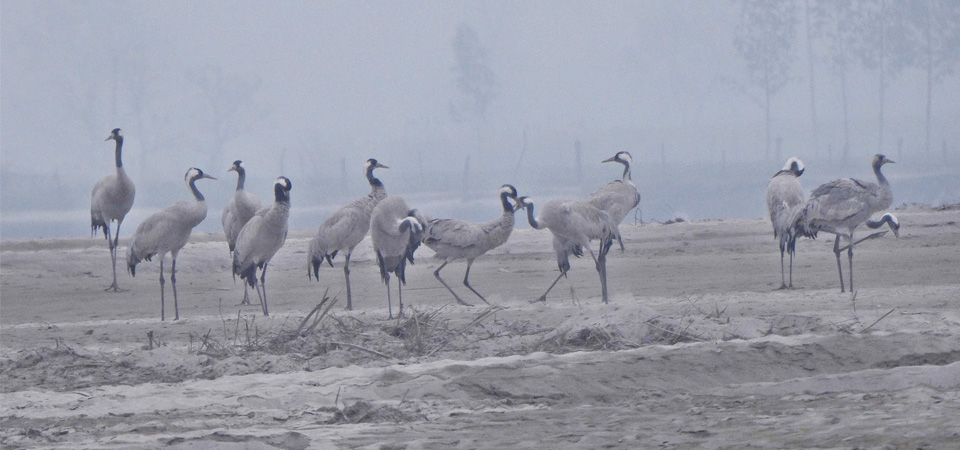Common Cranes reappear in Kailali after 18 years

By Abinash Chaudhary
Dhangadi, Jan. 23: Common Crane, called Laxman Sarus in Nepali, has appeared in Kailali after 18 years.
In all, 14 Common Cranes have been spotted in the lower riparian area of the Karnali River on the Sri Lanka Tapu in Tikapur Municipality.
At the same time, Greater White-fronted Goose were also sighted in the area for the first time. Of the four species of Sarus Crane found in Nepal, Common Crane is a migratory bird species, said Hirulal Dangaura, an ornithologist at the Nepal Bird Conservation Association (BCN). According to Dangaura, this is the second time the bird has been sighted in Kailali. Earlier in 2006, conservationist Bijay Raj Shrestha recorded the species in Mantriphanta, in Bhajani Municipality. Only after 18 years, they were spotted again on the banks of the Karnali River.
According to the BCN, Common Crane was first sighted in Nepal in the 19th century in the Terai, Hetauda and Kathmandu Valley. Of the four species found in Nepal, Greater Scaup and Sarus Crane are considered rare in the world.
The sensitive species recorded on the International Union for Conservation of Nature (IUCN) Red List is a year-round native bird found in the Lumbini region of the Western Terai of Nepal. However, there is a record that the Greater Scaup, though seemingly insignificant, was bred in Limi of Humla.
Common Crane and Demoiselle Crane are winter visitors and migratory birds. After the snowfall at the North Pole, these two species of birds migrate to India and Sri Lanka via Nepal every year in search of favourable weather, safe habitat and pasture, said Dangaura.
In that process, these birds have been living in Nepal if they find a suitable place here. According to a study conducted by the association in Mustang, about 15,000 Demoiselle Crane enter Nepal through the skies of Kaligandaki every year.
According to ornithologist Dangaura, the Sarus Crane is considered an indicator species of the wetland area. The presence of the bird indicates that the wetland area and ecosystem are healthy.
The birds of this species control the number of snakes and also help in the production of food by eating other species of insects including shellfish which poses threat to agriculture. In the same way, it can alert and prevent attacks when violent animals such as tigers and leopards approach the settlements.
The use of pesticides in agriculture, excessive and unmanaged use of wetland area is eroding the wetland. The species is being affected by the destruction of wetlands.
The main challenge for Crane Sarus is the rapid erosion of the wetland area, which is their habitat, said Dangaura. “They are also facing problems due to poaching and pollution,” he said.
Recent News

Do not make expressions casting dout on election: EC
14 Apr, 2022
CM Bhatta says may New Year 2079 BS inspire positive thinking
14 Apr, 2022
Three new cases, 44 recoveries in 24 hours
14 Apr, 2022
689 climbers of 84 teams so far acquire permits for climbing various peaks this spring season
14 Apr, 2022
How the rising cost of living crisis is impacting Nepal
14 Apr, 2022
US military confirms an interstellar meteor collided with Earth
14 Apr, 2022
Valneva Covid vaccine approved for use in UK
14 Apr, 2022
Chair Prachanda highlights need of unity among Maoist, Communist forces
14 Apr, 2022
Ranbir Kapoor and Alia Bhatt: Bollywood toasts star couple on wedding
14 Apr, 2022
President Bhandari confers decorations (Photo Feature)
14 Apr, 2022











